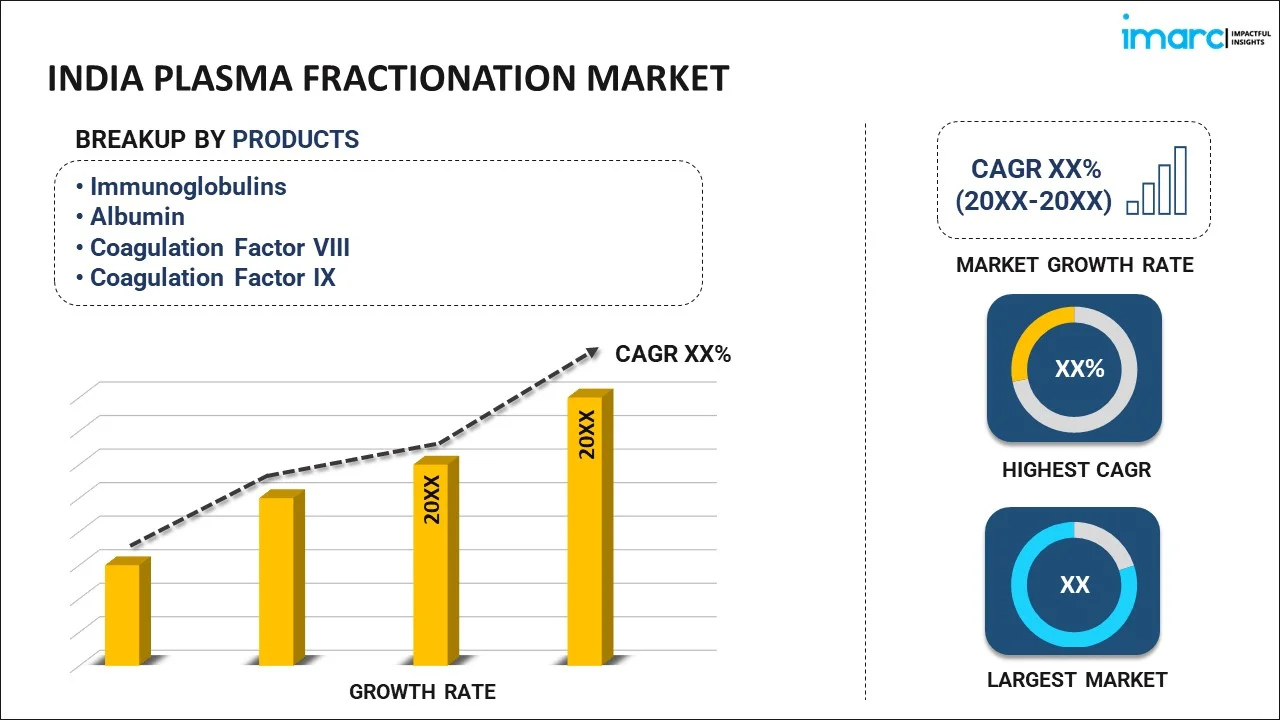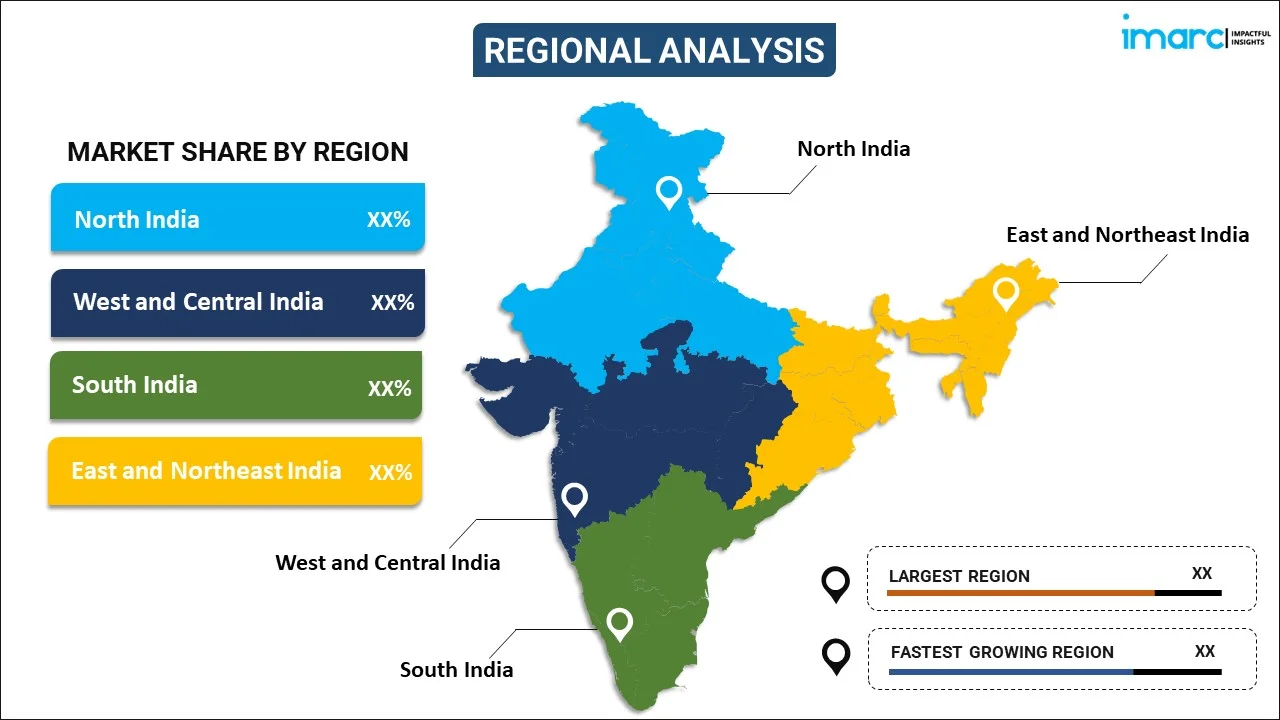
India Plasma Fractionation Market Report by Product (Immunoglobulins, Albumin, Coagulation Factor VIII, Coagulation Factor IX), Sector (Private Sector, Public Sector), Application (Neurology, Immunology, Hematology, and Others), End User (Hospitals and Clinics, Clinical Research Laboratories, Academic Institutes), and Region 2025-2033
Market Overview:
India plasma fractionation market size reached USD 373.8 Million in 2024. Looking forward, IMARC Group expects the market to reach USD 547.0 Million by 2033, exhibiting a growth rate (CAGR) of 4.32% during 2025-2033. The growing healthcare awareness among individuals is propelling the need for plasma-derived products, which is primarily driving the market growth across the country.
|
Report Attribute
|
Key Statistics
|
|---|---|
|
Base Year
|
2024 |
|
Forecast Years
|
2025-2033 |
|
Historical Years
|
2019-2024
|
| Market Size in 2024 | USD 373.8 Million |
| Market Forecast in 2033 | USD 547.0 Million |
| Market Growth Rate (2025-2033) | 4.32% |
Plasma fractionation is the downstream processing of donated plasma to create essential therapies and medicinal products. This involves the separation of plasma into distinct proteins or fractions through mechanical methods like centrifugation, depth filtration, precipitation, and chromatography. In contemporary fractionation processes, various techniques such as the manipulation of alcohol concentrations, duration, temperature, and pH are employed to extract specific therapeutic proteins. The advancement in technology complexity and the incorporation of in-process viral reduction treatments over the years have led to the emergence of novel protein therapeutics and enhancements in the purity and quality of the final products.
India Plasma Fractionation Market Trends:
The plasma fractionation market in India has seen notable growth, aligning with the increasing demand for life-saving therapeutic products derived from plasma. Additionally, mechanical separation methods, including centrifugation, depth filtration, precipitation, and chromatography, form the basis of plasma fractionation in India. Besides this, modern fractionation processes in the country have evolved, incorporating advanced techniques, such as the manipulation of alcohol concentrations, duration, temperature, and pH to extract targeted therapeutic proteins. These advancements contribute to the production of high-quality and effective plasma-derived therapies. The complexity of technology in plasma fractionation has increased over the years in India, leading to the development of new protein therapeutics, which is acting as another significant growth-inducing factor. Moreover, the introduction of in-process viral reduction treatments has significantly improved the purity and safety of the final products. This is particularly crucial in the context of ensuring the safety of therapeutic proteins derived from plasma. Furthermore, the India plasma fractionation market finds application in various therapeutic areas, including immunology, hematology, neurology, and critical care medicine. Additionally, advancements in technology and quality control measures will likely contribute to the continued expansion of the plasma fractionation market in India, thereby ensuring a stable supply of essential therapeutic proteins to meet the healthcare needs of the population.
India Plasma Fractionation Market Segmentation:
IMARC Group provides an analysis of the key trends in each segment of the market, along with forecasts at the country level for 2025-2033. Our report has categorized the market based on product, sector, application, and end user.
Product Insights:

- Immunoglobulins
- Albumin
- Coagulation Factor VIII
- Coagulation Factor IX
The report has provided a detailed breakup and analysis of the market based on the product This Includes immunoglobulins, albumin, coagulation factor VIII, and coagulation factor IX.
Sector Insights:
- Private Sector
- Public Sector
A detailed breakup and analysis of the market based on the sector have also been provided in the report. This includes private sector and public sector.
Application Insights:
- Neurology
- Immunology
- Hematology
- Others
The report has provided a detailed breakup and analysis of the market based on the application. This includes neurology, immunology, hematology, and others.
End User Insights:
- Hospitals and Clinics
- Clinical Research Laboratories
- Academic Institutes
A detailed breakup and analysis of the market based on the end user have also been provided in the report. This includes hospitals and clinics, clinical research laboratories, and academic institutes.
Regional Insights:

- North India
- West and Central India
- South India
- East and Northeast India
The report has also provided a comprehensive analysis of all the major regional markets, which include North India, West and Central India, South India, and East and Northeast India.
Competitive Landscape:
The market research report has also provided a comprehensive analysis of the competitive landscape. Competitive analysis such as market structure, key player positioning, top winning strategies, competitive dashboard, and company evaluation quadrant has been covered in the report. Also, detailed profiles of all major companies have been provided.
India Plasma Fractionation Market Report Coverage:
| Report Features | Details |
|---|---|
| Base Year of the Analysis | 2024 |
| Historical Period | 2019-2024 |
| Forecast Period | 2025-2033 |
| Units | Million USD |
| Scope of the Report | Exploration of Historical Trends and Market Outlook, Industry Catalysts and Challenges, Segment-Wise Historical and Future Market Assessment:
|
| Products Covered | Immunoglobulins, Albumin, Coagulation Factor VIII, Coagulation Factor IX |
| Sectors Covered | Private Sector, Public Sector |
| Applications Covered | Neurology, Immunology, Hematology, Others |
| End Users Covered | Hospitals and Clinics, Clinical Research Laboratories, Academic Institutes |
| Regions Covered | North India, West and Central India, South India, East and Northeast India |
| Customization Scope | 10% Free Customization |
| Post-Sale Analyst Support | 10-12 Weeks |
| Delivery Format | PDF and Excel through Email (We can also provide the editable version of the report in PPT/Word format on special request) |
Key Questions Answered in This Report:
- How has the India plasma fractionation market performed so far and how will it perform in the coming years?
- What has been the impact of COVID-19 on the India plasma fractionation market?
- What is the breakup of the India plasma fractionation market on the basis of product?
- What is the breakup of the India plasma fractionation market on the basis of sector?
- What is the breakup of the India plasma fractionation market on the basis of application?
- What is the breakup of the India plasma fractionation market on the basis of end user?
- What are the various stages in the value chain of the India plasma fractionation market?
- What are the key driving factors and challenges in the India plasma fractionation?
- What is the structure of the India plasma fractionation market and who are the key players?
- What is the degree of competition in the India plasma fractionation market?
Key Benefits for Stakeholders:
- IMARC’s industry report offers a comprehensive quantitative analysis of various market segments, historical and current market trends, market forecasts, and dynamics of the India plasma fractionation market from 2019-2033.
- The research report provides the latest information on the market drivers, challenges, and opportunities in the India plasma fractionation market.
- Porter's five forces analysis assist stakeholders in assessing the impact of new entrants, competitive rivalry, supplier power, buyer power, and the threat of substitution. It helps stakeholders to analyze the level of competition within the India plasma fractionation industry and its attractiveness.
- Competitive landscape allows stakeholders to understand their competitive environment and provides an insight into the current positions of key players in the market.
Need more help?
- Speak to our experienced analysts for insights on the current market scenarios.
- Include additional segments and countries to customize the report as per your requirement.
- Gain an unparalleled competitive advantage in your domain by understanding how to utilize the report and positively impacting your operations and revenue.
- For further assistance, please connect with our analysts.
 Inquire Before Buying
Inquire Before Buying
 Speak to an Analyst
Speak to an Analyst
 Request Brochure
Request Brochure
 Request Customization
Request Customization




.webp)




.webp)












